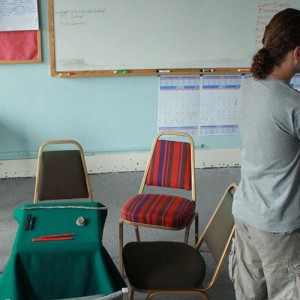In this episode, Evan and Willem speak about Willem’s session of “Where Are Your Keys?” he ran for story-gamers at ‘Gamestorm 12‘ in Portland, OR. WAYK is a highly designed game environment for community-driven language revitalization. This conversation about Willem’s game gets highly technical and into some of the minutiae that we think about as we constantly explore ways to improve the delivery and speed of the game.
Then, they move on to discuss the deeper ramifications of holding space for “same conversations”. Peter provides periodic burps in the background. Yes, I agree, it’s gross.
One last note – in these podcasts you will hear them refer to technique “Superman III” a lot. This technique essentially refers to the idea of harvesting as many tiny (and seemingly inconsequential) moments and opportunities as possible, which add up to an enormous amount of language acquisition. For more on the backstory of this technique name you can watch the movie ‘Superman III’, but to sum up: the computer hacker character in the movie embezzles millions of dollars from his employer by stealing fractions of a penny at a time from each individual paycheck sent out from a payroll service.
1. Technique “Fluency Play” at GAMESTORM 12
- Evan interviews Willem extensively on his “set-up” of the game at Gamestorm 12.
- The enjoyment of a game is inextricable from the learning of it. An effective game is fun to learn too.
- Joel Shempert, WAYK workshop veteran, blogger at Story by the Throat, and game designer of “the Dreaming Crucible”, inspired by WAYK “fluency play” principles.
- Kindergarten, Montessori, and ESL teachers seem to especially understand and appreciate WAYK.
- Willem claims he understands Geek Culture and adjusts his presentation of the game accordingly. Willem claims a lot of things.
- The “Supercomputer” metaphor.
2. Fierceness in Technique “Same Conversation“
- Mihaly Csikszentmihalyi, who writes and speaks about the ‘flow state’ that occurs when the challenge of a task balances perfectly with the skill of the performer, in an ongoing experience.
- The power of a fiercely guarded space for “Same Conversation“.
- Start small when beginning to hold space for a “same conversation“.
- Always design “backups” for your “same conversation“.
- Crisis, rather than safety and security, creates community.
- Handling the painful burden of the endangered language crisis.






In this podcast you talk about someone who will be taking an ASL course soon, and you suggested they “Round 2” it. What’s that?
Jay-
Technique “Round To It” means redirecting a conversation testing your fluency to subjects you can proficiently speak about – the ones you chose to focus on as you climbed the ladder of fluent proficiency.
Think of the politician trained well enough to redirect any question to his favorite talking points. This is the highest level of technique “round to it”.
I just noticed that the title of this post is missing the “, Episode” that every other podcast has.